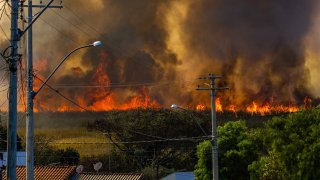
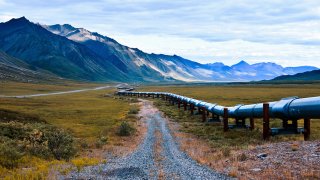


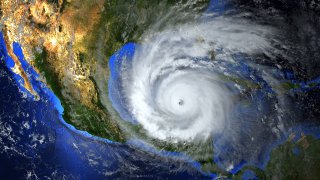
The U.S. energy system consists of all the infrastructure needed to collect, produce, distribute, store, and consume power for our homes, for our businesses, and while we are on the go. From manufacturing to agriculture, and health care to transportation, the nation depends on a stable energy supply.
Our energy system is vulnerable to a wide range of climate change impacts. These include rising temperatures and heat waves, cold and snow events, severe drought, intense rainfall, sea level rise, hurricanes, and wildfires. While these impacts differ from one region to another, they will continue to affect all areas of the country. 1 Moreover, impacts to one part of the energy system or in one region can affect other parts of the system or other areas.
Did You Know?




The energy sector is the largest emitter of greenhouse gases into the atmosphere, contributing to climate change. In turn, changes in climate can disrupt energy networks themselves, stress infrastructure, and pose safety risks to people. Read more about greenhouse gas emissions on the Basics of Climate Change page.
In addition, energy interacts with and depends on other sectors of the economy, such as water resources and transportation. Therefore, climate impacts on these sectors can affect the energy system.
Businesses, governments, and others are taking many actions to increase the resiliency of the energy system to climate change. For example, many states are upgrading and protecting their energy infrastructure from extreme weather. 2 Governments and businesses are sharing information with each other through private/public partnerships. Companies and researchers are developing and installing innovative and renewable technologies (such as wind and solar) that help reduce air pollution and greenhouse gas emissions. These actions not only help address vulnerabilities to the energy system, but also reduce the emissions that are making climate change worse.
Learn more about climate impacts on the energy sector :
Climate change may affect the energy sector at both local and regional scales. Four key impacts are described in this section.
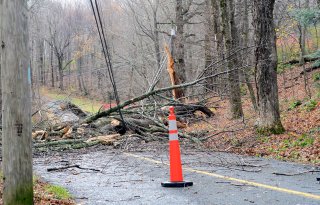
Extreme weather and natural disasters pose significant risks to the U.S. energy supply in all regions of the country. 3 Energy systems on both the Gulf and East Coasts face more risk of damage from flooding due to hurricanes and sea level rise. 4 More frequent and intense precipitation events are expected to increase the risk of flooding on infrastructure in the Northeast and the Midwest. 5 In Arctic regions like Alaska, thawing permafrost causes land to sink and compromise fuel pipelines and other energy infrastructure. 6
Overall, the climate is warming, and the atmosphere’s increasing capacity to hold moisture can lead to longer periods without rainfall. The warmth and variability in precipitation can lead to declining snowpack, shifts in snowmelt, and extended droughts—all of which affect water supplies needed for energy systems. For example, most U.S. power plants depend on rivers or lakes for cooling. 7 Petroleum, natural gas, and biofuels production and refining also require a steady supply of water. 8 Water shortages have already affected hydropower production, especially in the West. 9 Without enough water, affected systems need to find new water sources or scale back their operations.
Climate change threatens the ways in which power reaches our homes and businesses. 10 For example, transmission lines are prone to damage during extreme weather. Snow and ice, wildfires, and extreme wind can damage above-ground powerlines and transmission towers. 11 Flooding can affect underground powerlines and damage roads, railroads, pipelines, and storage facilities. 12 Near the coast, storm surge can destroy petroleum storage tanks and wash out roads and railways. 13
Warmer temperatures, especially hot summer temperatures, can affect power transmission. When temperatures rise, the carrying capacity of transmission lines decreases. 14 Summer months also present more wildfire risks, especially in the Southwest. 15 Wildfires can disrupt energy networks significantly when they affect transmission towers and powerlines. 16,17 In some areas, faulty or fallen powerlines (or lines that come in contact with trees) can start wildfires. This risk is why some utilities shut down powerlines when high winds are forecast. 18
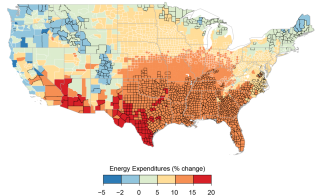 additional change in climate. Color indicates the magnitude of increases in energy expenditures in median projection; outline color indicates level of agreement across model projections (thin white outline, inner 66% of projections disagree in sign; no outline, more than 83% of projections agree in sign (continued on NCA site)" width="320" height="201" />
additional change in climate. Color indicates the magnitude of increases in energy expenditures in median projection; outline color indicates level of agreement across model projections (thin white outline, inner 66% of projections disagree in sign; no outline, more than 83% of projections agree in sign (continued on NCA site)" width="320" height="201" />
Temperatures are rising in all regions of the United States. 19 As the climate warms, Americans are expected to use more energy, mostly electricity, for cooling. 20 This higher demand will also increase the chance of blackouts or other power disruptions. 21
A warming climate also means that Americans are expected to use less energy for heating their homes in the winter. 22 However, increased summer demands for cooling are expected to outweigh any energy-use reductions from lower heating needs. 23
As the demand for cooling increases across the nation, more electricity must be produced to meet this demand. Increasing energy production is likely to increase emissions of certain air pollutants and greenhouse gases that contribute to climate change. 24,25
For more specific examples of climate change impacts in your region, please see the National Climate Assessment.
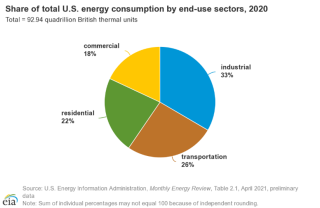
An affordable and reliable energy supply is critical to the country’s economy. 26 In 2020, the U.S. produced nearly 96 quadrillion British thermal units (Btu) of energy and consumed nearly 93 quadrillion Btu. 27 Energy produced in the United States, but not consumed here, is exported to other countries. Fossil fuels (petroleum, coal, and natural gas) accounted for nearly 80% of U.S. energy production—both electricity generation and energy consumed directly—in 2020. The primary consumer sectors of energy in the United States are the industrial, transportation, commercial, and residential sectors.
The energy system is an important source of employment for Americans, providing jobs for about 5.2 million people. 28 These jobs support power generation and transmission, fuel extraction and processing, and renewable energy and energy-efficiency installations and sales.
U.S. energy exports also contribute to the economy. In 2020, U.S. energy exports exceeded total energy imports, as the United States was a net exporter of petroleum products, natural gas, and coal. 29 Crude oil was the only major fuel type for which the United States was a net importer. 30
Major disturbances to the energy supply, such as power outages or fuel shortages, harm the economy. 31 For example, energy disruptions from extreme weather damage to energy infrastructure have cost billions of dollars. 32 The nation’s energy system is also aging, with many components not designed to withstand the extreme weather conditions projected for this century. 33
 Person holding an electricity bill" width="320" height="213" />
Person holding an electricity bill" width="320" height="213" />
Some communities have been historically overburdened by pollution. Low-income people, people of color, and linguistically isolated communities are more likely than the national average to live near power plants that burn fossil fuels. 35 This means they can be exposed to air pollutants that cause or contribute to health issues, such as respiratory and heart diseases. 36 As the climate changes and energy demand grows, communities may face increased levels of these emissions and associated risks.
Lower-income communities also carry a higher energy burden than those with higher incomes. On average, low-income households spend 8.6% of their income on energy expenses. 37 In comparison, non-low-income households spend 3%. 38 Many factors contribute to this burden. For example, low-income households may live in housing without insulation or with outdated appliances. 39 This energy burden may increase as the climate changes and energy demand goes up.
In addition, low-income communities often face barriers to accessing clean technologies that make energy more affordable. For instance, as of 2018, less than half of community-scale solar projects included households with lower incomes. 41
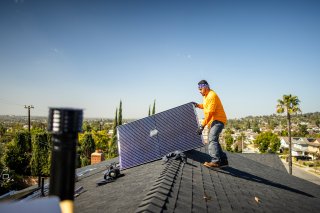
We can reduce climate change’s impact on the energy sector in many ways, including the following:
See additional actions you can take, as well as steps that companies can take, on EPA’s What You Can Do About Climate Change page.
1 Zamuda, C., et al. (2018). Ch. 4: Energy supply, delivery, and demand. In: Impacts, risks, and adaptation in the United States: Fourth national climate assessment, volume II. U.S. Global Change Research Program, Washington, DC, p. 178.
2 Zamuda, C., et al. (2018). Ch. 4: Energy supply, delivery, and demand. In: Impacts, risks, and adaptation in the United States: Fourth national climate assessment, volume II. U.S. Global Change Research Program, Washington, DC, p. 186.
4 Zamuda, C., et al. (2018). Ch. 4: Energy supply, delivery, and demand. In: Impacts, risks, and adaptation in the United States: Fourth national climate assessment, volume II. U.S. Global Change Research Program, Washington, DC, p. 181.
5 Zamuda, C., et al. (2018). Ch. 4: Energy supply, delivery, and demand. In: Impacts, risks, and adaptation in the United States: Fourth national climate assessment, volume II. U.S. Global Change Research Program, Washington, DC, p. 178.
6 Zamuda, C., et al. (2018). Ch. 4: Energy supply, delivery, and demand. In: Impacts, risks, and adaptation in the United States: Fourth national climate assessment, volume II. U.S. Global Change Research Program, Washington, DC, p. 180.
7 Zamuda, C., et al. (2018). Ch. 4: Energy supply, delivery, and demand. In: Impacts, risks, and adaptation in the United States: Fourth national climate assessment, volume II. U.S. Global Change Research Program, Washington, DC, p. 182.
8 Zamuda, C., et al. (2018). Ch. 4: Energy supply, delivery, and demand. In: Impacts, risks, and adaptation in the United States: Fourth national climate assessment, volume II. U.S. Global Change Research Program, Washington, DC, p. 182.
9 Zamuda, C., et al. (2018). Ch. 4: Energy supply, delivery, and demand. In: Impacts, risks, and adaptation in the United States: Fourth national climate assessment, volume II. U.S. Global Change Research Program, Washington, DC, p. 182.
10 Zamuda, C., et al. (2018). Ch. 4: Energy supply, delivery, and demand. In: Impacts, risks, and adaptation in the United States: Fourth national climate assessment, volume II. U.S. Global Change Research Program, Washington, DC, p. 180.
11 Zamuda, C., et al. (2018). Ch. 4: Energy supply, delivery, and demand. In: Impacts, risks, and adaptation in the United States: Fourth national climate assessment, volume II. U.S. Global Change Research Program, Washington, DC, p. 180.
12 Zamuda, C., et al. (2018). Ch. 4: Energy supply, delivery, and demand. In: Impacts, risks, and adaptation in the United States: Fourth national climate assessment, volume II. U.S. Global Change Research Program, Washington, DC, p. 179.
13 Zamuda, C., et al. (2018). Ch. 4: Energy supply, delivery, and demand. In: Impacts, risks, and adaptation in the United States: Fourth national climate assessment, volume II. U.S. Global Change Research Program, Washington, DC, p. 180.
15 Zamuda, C., et al. (2018). Ch. 4: Energy supply, delivery, and demand. In: Impacts, risks, and adaptation in the United States: Fourth national climate assessment, volume II. U.S. Global Change Research Program, Washington, DC, p. 176.
16 Lall, U., et al. (2018). Ch. 3: Water. In: Impacts, risks, and adaptation in the United States: Fourth national climate assessment, volume II. U.S. Global Change Research Program, Washington, DC, pp. 153–154.
17 Zamuda, C., et al. (2018). Ch. 4: Energy supply, delivery, and demand. In: Impacts, risks, and adaptation in the United States: Fourth national climate assessment, volume II. U.S. Global Change Research Program, Washington, DC, p. 177.
19 Zamuda, C., et al. (2018). Ch. 4: Energy supply, delivery, and demand. In: Impacts, risks, and adaptation in the United States: Fourth national climate assessment, volume II. U.S. Global Change Research Program, Washington, DC, p. 178.
20 Zamuda, C., et al. (2018). Ch. 4: Energy supply, delivery, and demand. In: Impacts, risks, and adaptation in the United States: Fourth national climate assessment, volume II. U.S. Global Change Research Program, Washington, DC, p. 178.
21 Zamuda, C., et al. (2018). Ch. 4: Energy supply, delivery, and demand. In: Impacts, risks, and adaptation in the United States: Fourth national climate assessment, volume II. U.S. Global Change Research Program, Washington, DC, p. 181.
22 Zamuda, C., et al. (2018). Ch. 4: Energy supply, delivery, and demand. In: Impacts, risks, and adaptation in the United States: Fourth national climate assessment, volume II. U.S. Global Change Research Program, Washington, DC, p. 181.
23 Zamuda, C., et al. (2018). Ch. 4: Energy supply, delivery, and demand. In: Impacts, risks, and adaptation in the United States: Fourth national climate assessment, volume II. U.S. Global Change Research Program, Washington, DC, p. 181.
24 Zamuda, C., et al. (2018). Ch. 4: Energy supply, delivery, and demand. In: Impacts, risks, and adaptation in the United States: Fourth national climate assessment, volume II. U.S. Global Change Research Program, Washington, DC, p. 181.
25 Nolte, C., et al. (2018). Ch. 13: Air quality. In: Impacts, risks, and adaptation in the United States: Fourth national climate assessment, volume II. U.S. Global Change Research Program, Washington, DC, p. 514.
26 Zamuda, C., et al. (2018). Ch. 4: Energy supply, delivery, and demand. In: Impacts, risks, and adaptation in the United States: Fourth national climate assessment, volume II. U.S. Global Change Research Program, Washington, DC, p. 178.
27 U.S. Energy Information Administration (EIA). (2021). U.S. energy facts explained. Retrieved 3/2/2022.
28 U.S. Department of Energy (DOE). (2022). United States energy & employment report 2021: Executive summary. Department of Energy Office of Policy, Office of Energy Jobs, p. vi.
29 U.S. Energy Information Administration (EIA). (2021). U.S. energy facts explained. Retrieved 3/2/2022.
30 U.S. Energy Information Administration (EIA). (2021). U.S. energy facts explained. Retrieved 3/2/2022.
31 Zamuda, C., et al. (2018). Ch. 4: Energy supply, delivery, and demand. In: Impacts, risks, and adaptation in the United States: Fourth national climate assessment, volume II. U.S. Global Change Research Program, Washington, DC, p. 185.
32 Zamuda, C., et al. (2018). Ch. 4: Energy supply, delivery, and demand. In: Impacts, risks, and adaptation in the United States: Fourth national climate assessment, volume II. U.S. Global Change Research Program, Washington, DC, p. 185.
33 Zamuda, C., et al. (2018). Ch. 4: Energy supply, delivery, and demand. In: Impacts, risks, and adaptation in the United States: Fourth national climate assessment, volume II. U.S. Global Change Research Program, Washington, DC, p. 185.
34 U.S. Energy Information Administration (EIA). (2021). U.S. energy facts explained. Retrieved 3/2/2022.
36 Nolte, C., et al. (2018). Ch. 13: Air quality. In: Impacts, risks, and adaptation in the United States: Fourth national climate assessment, volume II. U.S. Global Change Research Program, Washington, DC, p. 514.
37 Office of Energy Efficiency & Renewable Energy. Low-income community energy solutions. Retrieved 3/2/2022.
38 Office of Energy Efficiency & Renewable Energy. Low-income community energy solutions. Retrieved 3/2/2022.
39 Office of Energy Efficiency & Renewable Energy. Low-income community energy solutions. Retrieved 3/2/2022.
42 California Department of Forestry and Fire Protection. (2022). CAL FIRE investigators determine cause of the Dixie Fire. Retrieved 5/11/2022.
43 Zamuda, C., et al. (2018). Ch. 4: Energy supply, delivery, and demand. In: Impacts, risks, and adaptation in the United States: Fourth national climate assessment, volume II. U.S. Global Change Research Program, Washington, DC, p. 178.
47 Zamuda, C., et al. (2018). Ch. 4: Energy supply, delivery, and demand. In: Impacts, risks, and adaptation in the United States: Fourth national climate assessment, volume II. U.S. Global Change Research Program, Washington, DC, p. 178.
48 Zamuda, C., et al. (2018). Ch. 4: Energy supply, delivery, and demand. In: Impacts, risks, and adaptation in the United States: Fourth national climate assessment, volume II. U.S. Global Change Research Program, Washington, DC, p. 180.
49 Zamuda, C., et al. (2018). Ch. 4: Energy supply, delivery, and demand. In: Impacts, risks, and adaptation in the United States: Fourth national climate assessment, volume II. U.S. Global Change Research Program, Washington, DC, p. 181.